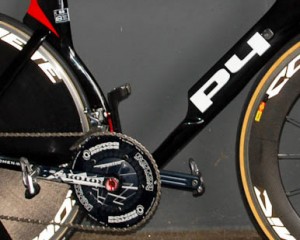 The UCI’s Approval Program of Frames and Forks “sees strong demand by the industry.” At least that is what the subject line of a press release that the UCI sent out a couple months ago stated. If you have read any of my past posts about the UCI, you can probably guess that I don’t completly buy that statement. To be fair though, it might really depend on whom in the industry that you ask. Big companies like Trek, Specialized, Cannondale, Giant, etc. may be able to afford the frame approval process for each new model, but the fear is that the policy will effectively eliminate the opportunity for smaller companies to sponsor a pro team. Sure there is the recent agreement with The Framebuilders’ Collective, to reduce the approval costs for that group, but I don’t really see that as a solution for all the companies in between the small framebuilders and the few large global bicycle corporations.
The UCI’s Approval Program of Frames and Forks “sees strong demand by the industry.” At least that is what the subject line of a press release that the UCI sent out a couple months ago stated. If you have read any of my past posts about the UCI, you can probably guess that I don’t completly buy that statement. To be fair though, it might really depend on whom in the industry that you ask. Big companies like Trek, Specialized, Cannondale, Giant, etc. may be able to afford the frame approval process for each new model, but the fear is that the policy will effectively eliminate the opportunity for smaller companies to sponsor a pro team. Sure there is the recent agreement with The Framebuilders’ Collective, to reduce the approval costs for that group, but I don’t really see that as a solution for all the companies in between the small framebuilders and the few large global bicycle corporations.
As I walked around looking at pro team time trial bikes this past weekend, I couldn’t help but wonder how many of the equipment sponsors (if any) really do welcome the UCI frame approval process. Tejay Van Garderen’s HTC Highroad Specialized Shiv was the first bike I spotted that brought the new approval process to mind. As you probably remember, that bike was a high profile example of a frameset that was outlawed by the UCI after it went into production because the front of the headtube was deemed to be a fairing. The engineers at Specialized had to scramble, but the third generation of the Shiv was finally considered to be legal by the UCI, after considerable additional development expense by the company.
 The Cervelo P4 was another frame that the UCI decided was not in compliance with their equipment guidelines after it went into production. In the case of the P4, the integrated aero waterbottle and cage was the offending detail that supposedly gave an unfair advantage, so Gamin Cervelo riders had to race with a standard bottle cage on the frame leaving the cutout in the downtube wide open.
The Cervelo P4 was another frame that the UCI decided was not in compliance with their equipment guidelines after it went into production. In the case of the P4, the integrated aero waterbottle and cage was the offending detail that supposedly gave an unfair advantage, so Gamin Cervelo riders had to race with a standard bottle cage on the frame leaving the cutout in the downtube wide open.
Looking at those two bikes last Saturday, I couldn’t help but wonder; could the new UCI frame and fork approval program actually have saved these companies time and money in the development of these bikes? If the Shiv had been officially ‘stickered’ from the beginning, it would have saved Specialized the considerable expense of a series of redesigns to make the bike UCI legal, right? I guess that is one way to look at it, but I still have a hard time justifying the stickering program based on that argument. A better way to ensure that companies don’t waste money developing non-compliant bikes would be to simply make sure the equipment guidelines are clear and easy to understand. If the UCI wants to regulate rider position, basic frame shape, and even weight…fine. My big problem with their equipment restrictions is that they seem to be arbitrary and interpreted differently whenever something new comes along. If the UCI’s goal really is to make competition fair, a few simple to understand rules regarding equipment should suffice. On the other hand, if the goal is to stifle innovation and make some money along the way…then I’d say the boys in Switzerland are on the right track.
So what do you think? Are there any industry people out there who strongly support the UCI frame and fork approval process? If so, I’d love to hear your thoughts. Likewise, I’d love to hear from any of you in the industry who have some reservations about the policy (you can even comment anonymously if you prefer to stay on the UCI’s good side).

Leave a Reply to Champs Cancel reply